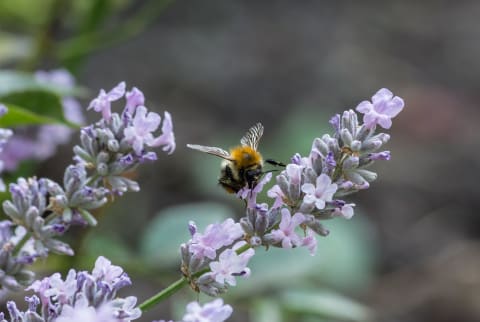Advertisement
4 Essential Features Of A Pollinator-Friendly Garden


Pollinators make the world go 'round. These essential critters fertilize plants of all kinds, and we have them to thank for most of the flowers and food on earth. And we're not just talking honeybees: While they are certainly the most prolific pollinator because of their incredible nests, beetles, wasps, butterflies, moths, hummingbirds, and flies all play an important role in carrying pollen from point A to point B.
Climate change, habitat loss, and pesticide use continue to threaten pollinators1, and, by extension, the health of the natural world. In honor of Pollinator Week, today we're sharing a few ways to design a wildlife-friendly yard that helps them bounce back:
Go for native plants.
Pollinators tend to prefer native plants over non-natives and ornamentals for a few reasons. For starters, they co-evolved with these plants, and some actually can't survive without their particular type of pollen.
"At least a quarter of native bees, of which there are 4,000 species in North America, require pollen from the plants that they evolved with," Nancy Lawson, naturalist and author of The Humane Gardener: Nurturing a Backyard Habitat for Wildlife, tells mbg. "The pollen they're bringing back to their nest has to be from certain plants or families of plants."
Non-natives are more likely to overtake other plants in your garden and become invasive, while some ornamental plants that are bred for aesthetics can hide pollen and nectar in their decorative petals, making it harder for pollinators to find.
With that being said, something is better than nothing, and a yard full of non-native plants is usually preferable to one that just has bare grass. "The presence of a lawn means the absence of all these other habitat elements," Lawson says. A yard with flowers, shrubs, trees, and water features will be much more appealing to pollinators (not to mention, humans).
Plant a variety of species.
Since different specialist pollinators seek out different plants, filling your yard with a variety of species will attract the widest variety of critters. Lawson recommends choosing plants, trees, and shrubs of various sizes that flower at different points of the year. Typically, the more colors, scents, shapes, and even humidity levels in your garden, the better—but make sure to plant them in patches that are large enough for pollinators to spot. "Just having one plant is usually not as good as having a grouping of that plant," she says.
Swap out mulch for natural ground cover.
If you're looking to suppress weeds, mulch can be really effective. However, it almost does too good a job covering the ground, as it doesn't leave any exposed soil for ground-nesting pollinators to call home. "Seventy percent of native bees are ground nesters, so that's really important," Lawson says.
Instead, she recommends using ground covers like violets, golden ragwort, wild basil, and wild strawberries that will leave some patches of dirt exposed as they grow. Some of them also have flowers that pollinators can feed on.
Keep your yard dark at night.
Just as they throw off human sleep-wake schedules, bright lights at night disrupt some critters' routines and can keep them from pollinating effectively. If you've ever watched moths swarm around a bright porch spotlight for hours, you've seen this in action. "They're so attracted to the light that they're not engaging in their normal behavior," says Lawson. To keep your pollinators focused on the task at hand, turn off any outdoor lights when you're not using them.
Watch Next
Enjoy some of our favorite clips from classes
Enjoy some of our favorite clips from classes
What Is Meditation?
Mindfulness/Spirituality | Light Watkins
Box Breathing
Mindfulness/Spirituality | Gwen Dittmar
What Breathwork Can Address
Mindfulness/Spirituality | Gwen Dittmar
The 8 Limbs of Yoga - What is Asana?
Yoga | Caley Alyssa
Two Standing Postures to Open Up Tight Hips
Yoga | Caley Alyssa
How Plants Can Optimize Athletic Performance
Nutrition | Rich Roll
What to Eat Before a Workout
Nutrition | Rich Roll
How Ayurveda Helps Us Navigate Modern Life
Nutrition | Sahara Rose
Messages About Love & Relationships
Love & Relationships | Esther Perel
Love Languages
Love & Relationships | Esther Perel

















